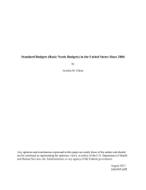Standard Budgets (Basic Needs Budgets) in the United States Since 2006
Standard Budgets (Basic Needs Budgets) in the United States Since 2006
Abstract
A “standard budget” is a list of goods and services that a family of a specified size and composition–and sometimes of a specified social class or occupational group–would need to live at a designated level of well-being, together with the estimated monthly or annual costs of those goods and services (Innes 1990; Orshansky 1959). Other terms used for the “standard budget” concept in recent American literature include “basic needs budget,” “family budget,” and “expert budget.” In other countries such as Britain and Australia, the term used for this concept in recent literature is “budget standard(s)” (Fisher 2007).
Since about 1990, a number of analysts have developed standard budgets in the United States, Britain, Australia, Canada, Ireland, and other countries. For a paper reviewing this work from about 1990 through 2006, see Fisher (2007).
The present paper updates the 2007 paper for the U. S. only, covering work since 2006. The majority of budgets referenced are still for working-age families with children at a “no-frills” standard of living, but there are more exceptions to that generalization than there were during the 1990-2006 period.




